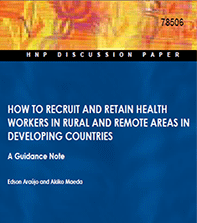Resource Spotlight: How to Recruit and Retain Health Workers in Rural and Remote Areas in Developing Countries
There is an emerging consensus that in order for interventions for recruitment and retention in rural and remote areas to be effective, they need to be implemented in bundles, combining different packages of interventions according to the variety of factors influencing the health worker's decision to work in rural or remote areas; and that policy makers need to match the interventions with health worker's preferences and expectations, since the health worker's employment decisions are a function of these preferences.
This paper aims to outline the magnitude of unequal health workforce distribution in the developing countries; provide a summary of the evidence to date on the factors that contribute to these imbalances; present a systematic set of policy interventions that are being implemented around the world to address the problem of recruitment and retention of health workers in rural and remote regions of the developing countries; and to introduce the potential application of the Discrete Choice Experiments (DCEs) to elicit health workers’ preferences and determine the factors likely to increase their probability of taking up a rural or remote job. [adapted from abstract]
View this resource.
The HRH Global Resource Center has other resources on this topic including:
- Why Would I Go There? Motivating Workers to Take and Keep Jobs in Rural Areas
- Differences in Preferences for Rural Job Postings between Nursing Students and Practicing Nurses: Evidence from a Discrete Choice Experiment in Lao People's Democratic Republic
- Factors that Influence Midwifery Students in Ghana When Deciding Where to Practice: A Discrete Choice Experiment
For additional resources on this topic, visit the Accreditation subject category.
Past Resource Spotlights
- 907 reads





